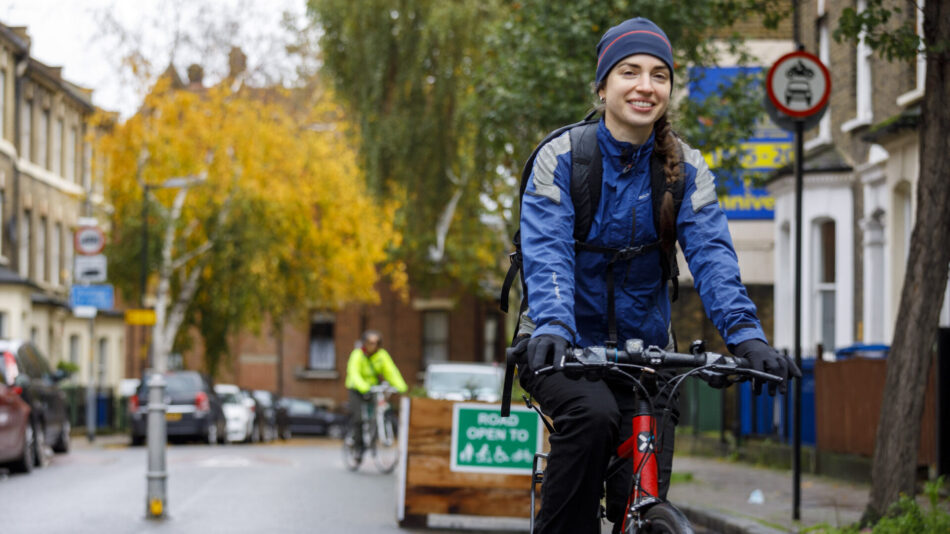

The government, lagging badly in the polls, has published further guidance and a review it has commissioned on Low Traffic Neighbourhoods (LTNs), to bolster its ‘Plan for Drivers’. In doing so, in the DfT press release, Secretary for Transport Mark Harper said “we’re on the side of drivers… making their lives better, fairer and cheaper, and helping people travel in the way that works best for them.”
Of course, the widely accepted theory of ‘induced demand’ is that the easier you make it for folks to drive, the more people drive, the worse the impacts of driving are etc. Given a huge proportion of the UK doesn’t have car access – and that’s particularly visible in cities like London – it’s not clear how more driving is “fairer” for anyone, including drivers.
The central part of the new announcement is the long-awaited and much-talked-up ‘review’ of LTN schemes the government ordered. The government talked this up as if it was going to showcase all that is ‘wrong’ with LTNs. Except, leaked last week to The Guardian, then fully released now, it does the opposite.
Broadly, the findings for 99 LTNs delivered since the start of the pandemic revealed, that LTNs cut traffic volumes and pollution levels (although the results on boundary roads can be “mixed”), don’t impact emergency services response times (again, results for Disabled people are “mixed”), and do cut road danger and crime.
Less than 20 percent of those delivered during the pandemic have since been removed – marking the LTN schemes and indeed the ‘trial then consult’ approach as being successful in broad terms. And while many residents are unclear across the four LTN schemes surveyed in greater detail (near 60% of residents didn’t know there was an LTN), support among these people is generally twice the level of opposition.
It’s interesting too that proportions of support and opposition were broadly replicated across all ages and genders and for those who responded as Disabled or with a health condition. Interestingly, those who said they were business owners in the area were markedly more positive about the LTNs than the general responses. Perhaps unsurprisingly, those opposed to the LTN were also more likely to not see issues with pollution and traffic as seriously.
So, in response to broadly good news the government has now learnt about LTNs and active travel, the government announces a… “crackdown” on good things.
The most worrying is that the government is threatening to restrict access to the DVLA database for councils and highways authorities who are ‘ripping off’ drivers. The government has issued a “call for evidence” on the issue, citing 43% of fines from cameras that are challenged get overturned on appeal (the page fails to mention how many are never challenged, of course).
The threat would be to withhold the ability for councils to use ANPR licence-plate cameras to enforce LTN filters. But this could also impact yellow box junctions, enforcement of parking on main roads, enforcement for red lights, bus gates, bus lanes etc. With emergency services representatives pushing to some extent for camera rather than physical (bollard and/or planter) filtering so they can drive through in an emergency, then it’d be a brave council that went back to just using lockable bollards everywhere – and existing filters could be rendered useless overnight.
However, savvy commentators suggest the likelihood that this will actually turn from a call for evidence into action is remote. The call for action is open until mid-May – then there’d need to be time to work through the evidence, formulate proposals, and they’d likely need primary legislation, from a Parliament heading into summer recess, out of legislative time, and then likely to see a general election.
The government also announced new guidance on LTN rollouts as well this weekend, in their Plan for Drivers update bonanza. This, on closer inspection, amounts to saying ‘do more consultation and engagement’ (which is a good idea generally), including potentially public opinion polling, which is a great idea – given particularly that representative polling can be done relatively cheaply for councils now, and to tends capture a wider range of views, more positive ones, than consultation surveys dominated typically by angry drivers.
However, buried in the fine print is one rather concerning point, that councils must be “confident that a scheme is capable of carrying the support of a majority of the community before introducing it”. Initial read suggests that this implies a council could be in hot water if it implements a traffic reduction scheme where a majority of residents oppose the scheme overall. This does occasionally happen – because as the mantra goes ‘consultations are not referendums’.
You’re asking residents to opine on traffic reduction schemes using local expertise to improve them in consultations, as our expert guide makes clear. You’re not asking, nor should you be asking, residents to form policy or say ‘yay or nay’ to schemes. The decisions for such lie with the democratically elected councillors.
Anti-20 mph guidance, that the media and some commenters have characterised as ‘only do 20mph outside schools’ turns out not to be so bold either, fortunately. The guidance also suggests 20mph is a perfectly good approach for residential areas and main roads (mainly in urban areas) where people are walking or cycling in numbers.
Tucked at the back, the new bus priority report, released as part of this update pack also manages to sneak in several positive road safety ideas, referencing both “side road closures” and “bus gates” as key bus priority measures to get buses moving quicker, when of course both are also part of common Low Traffic Neighbourhood designs. Sadly, however, even here the government is trying to turn something that is good for people into something good for cars. sadly – the guidance headlines with advice to councils to consider reducing hours for bus lanes wherever possible to let more cars get in the lanes (of course, the times bus lanes are not as needed are the times when extra car capacity is also needed less)!

Help us build a cycling city
The best way to support our work making London better for cycling for everyone is to join us as a member. You'll be joining over 12,000 other Londoners calling for cycling to be made safer and more enjoyable in every borough. Join today to make your voice heard and receive a host of great benefits.
Keep up to date
